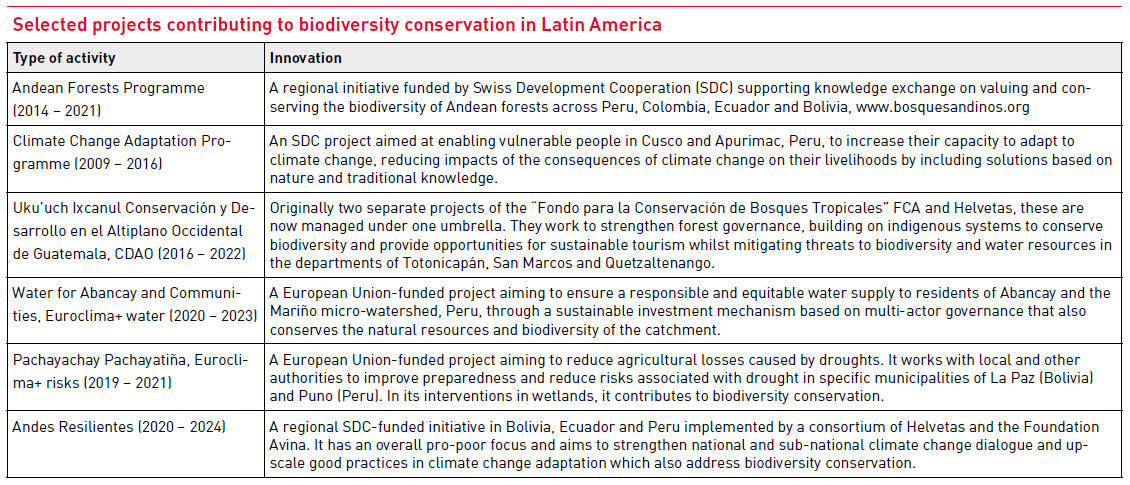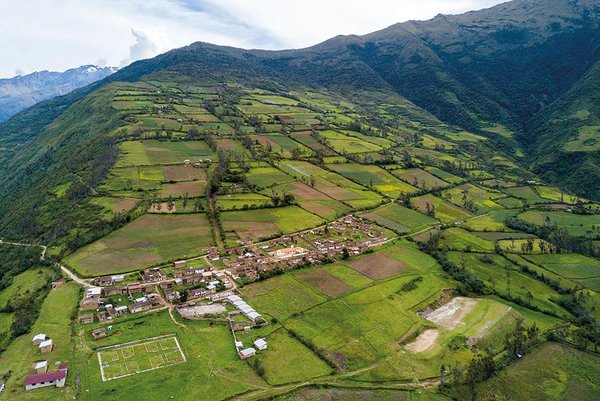 Download this article in magazine layout
Download this article in magazine layout
- Share this article
- Subscribe to our newsletter
Conserving biodiversity, meeting people’s needs
Throughout the world, economic development and human prosperity has often taken place at the expense of biodiversity. Where areas of the planet’s once rich flora and fauna remain, it makes sense to work with the people living closest to this biodiversity, supporting conservation efforts through their participation – and in so doing, generating livelihood opportunities. This, of course, is the basic theory of change of many projects aiming to interlink conservation and local livelihood objectives. It is also implicit in the post-2020 global biodiversity framework (GBF) Action Targets (albeit not yet ratified). Arguably, there are two main approaches. One is productive use, generating additional value from the resource or areas immediately around it through sustainable harvesting, resource management and cash crop development (often for ecologically sensitised niche export markets). The other main approach is to avoid harvesting and generate additional value from the resource through payments to restore or conserve it.
Where possible, Helvetas aims to integrate these two approaches through supporting land use planning at a landscape level – recognising that productive systems are also closely interlinked with the natural services of ecosystems and their biodiversity (see also article "How to preserve the multifunctionality of forested landscapes"). In areas delineated for productive use, interventions may support agrobiodiversity for food security or value chains such as cocoa, coffee or plants that provide natural ingredients for food and cosmetics. In areas delineated for conservation, there is often a particularly strong element of supporting governance structures at community level and beyond, linked with awareness raising about the intrinsic value of the resource. In this article, we examine selected projects in Latin America that focus on – or contain strong elements of – the latter approach (see Box).

The biodiversity hotspots of Mesoamerica and the Andes
The concept of “biodiversity hotspots” is often used for prioritising biodiversity conservation interventions. Terrestrial spaces having such a label must meet two criteria: high endemism of vascular plants and at least 30 per cent of the natural vegetation intact.
Helvetas works in two important biodiversity hotspots: Mesoamerica and the Tropical Andes. The former comprises the subtropical and tropical ecosystems from central Mexico to the Panama Canal, including all of Guatemala, Belize, El Salvador, Honduras, Nicaragua and Costa Rica, as well as a third of Mexico and nearly two-thirds of Panama. The latter extends from western Venezuela to northern Chile and Argentina, and includes large portions of Colombia, Ecuador, Peru and Bolivia. Both have important global relevance as centres of origin (e.g. maize, potato, tomato, beans and other crops and animals originating in Central and South America), and as the habitat of numerous endemic species, with unique ecosystems. They are both home to more than 60 indigenous groups; over 70 per cent of species of animals and plants in the world are found within their boundaries. Both also suffer similar stresses and threats to livelihoods and biodiversity, such as conflicts over land ownership, land use changes, deforestation, illegal activities and weak institutions for natural resource management.
Incentives and subsidies for biodiversity conservation
The main incentive for biodiversity conservation used by our selected projects is revenue generation from ecotourism, whilst the main form of subsidy is payment for environmental services (PES).
Ecotourism has, in theory, high potential for revenue generation. This has been demonstrated in the seven municipalities around the caldera of the volcano Uku’uch Ixcanul in Guatemala, where Helvetas has been working on promoting various community tourism initiatives since 2016. These include rural homestays, the production and sale of handicrafts and food items, guided forest tours, zip lines, hot springs, and swimming areas. Project data shows that 27,871 local people, 53 per cent of them women, have actively participated in these activities – generating an additional income for 4,661 families. The forest covered in this initiative, totalling more than 14,800 hectares, is under the ownership of the municipalities. This means that forest conservation and the benefits associated with it through attracting tourists can be directly linked. Each municipality has a different co-management structure, but in all cases community committees contribute to the planning and implementation of conservation objectives such as the efficient use of firewood (woodlot plantations, wood-saving stoves), forest fire prevention, restoration using native species, biological monitoring, and compensation mechanisms for downstream water supplies (PES). In some cases, the municipalities charge tourists an entrance fee (usually two or three US dollars) in addition to charging separately for the services offered; sometimes the communities charge the fees directly themselves.
Many of the tourists who have visited the Uku’uch Ixcanul came from other countries – the USA and Europe as well as Latin America. Inevitably, the COVID-19 pandemic has halted this flow of visitors and has shown the danger of relying on external actors. In future, greater focus will be placed on attracting local tourists, especially over festival periods. These are easier to manage in terms of predictable timing; local tourism could also be a new form of validating traditional heritage and strengthening community identity.
The earliest PES mechanisms supported through our selected projects generally focused on payment for a safe and reliable water supply. Under such schemes, downstream communities contribute financially to forest, wetland or grassland restoration and/ or conservation activities conducted by communities living in the upper reaches of the catchment. For example, under the Andean Forests Programme and the Euroclima+ water project in the Department of Apurímac, Peru (see Box above), the rural communities (Ccerabamba, Huironay, Pacchani, Kiuñalla, Atumpata, Llanucancha and Micaela Bastidas) have come together with the regional and municipal governments and the private water and sewerage service providers to form the MERESEH (this is the Spanish acronym for water ecosystem service compensation mechanisms) for the city of Abancay.
This process began in 2015 and was finally approved and implemented in 2020. A Reserve Fund was created, operated by a coordination committee led by the public water and sewage provider company, with the participation of the communities involved. An eco-hydrological system, implemented since 2017, is one of the main monitoring tools of MERESEH. Under this, hydrological variables (runoff, volume and evaporation), climatic variables (precipitation and temperature) and bio-physical variables (soil moisture, groundwater level in bogs and species composition) are all monitored as part of the annual workplan.
Various other pilot PES schemes are being provided with technical advice through the Andean Forests Programme. One example is in the rural commune of Kiuñalla in Apurimac, where 300 families receive payment for conserving 500 ha of indigenous forest and grasslands. Under the original agreement in 2019, this mechanism was devised to ensure downstream water supplies; however, it has now been expanded to include carbon credits through the platform Regenera. This platform channels voluntary contributions from companies seeking to offset their carbon footprint. Kiuñalla is also a national pilot of forest restoration under the national forestry authority.
Another example of a pilot PES mechanism comes from Colombia. In 2016, the Andean Forests Programme supported the Metropolitan Area of the Aburrá Valley and Masbosques in the implementation of a BancO2 agreement (a funding mechanism, see banco2.com) in the framework of a Pact for Forests. This platform brings together civil society institutions and public and private sector entities interested in forest conservation and restoration to collaborate under time-bound agreements. Specifically, 300 farming families are receiving payment to conserve the important ecosystems on their land. Funds also come from carbon credits and are conditional on the communities adhering to a forest management plan with provisions for improving the quality and quantity of water, soil protection and the protection of flora and fauna. The plan also makes provisions for the education of children and medical treatment of the elderly.
Some lessons learned
Many countries in Latin America have now developed PES polices and regulations, recognising their potential for revenue generation. Nevertheless, developing PES solutions on the ground is time consuming, generally requiring multiple partnerships between very different types of organisations (such as multiple levels of government administrations, private companies, NGOs and scientific institutions). A strong institutional mechanism with good governance is needed, whether organised through the public or private sector. Our experience shows that if adequate resources are invested in establishing such a sound mechanism, it can be a very sustainable solution.
We have observed that the protection of natural resources is often assumed to equate the conservation of biodiversity; sometimes this is backed by data, and sometimes not. For the future, we feel it is important that the biodiversity is systematically verified – for example, through recording sightings of indicator species or periodic monitoring of species composition in sample plots. Although such monitoring has associated costs, these can be integrated into activities; one means of doing so is to engage university students who use the findings as part of their studies (as long as this is done in a collaborative, “win-win” manner).
Many hopes have been pinned on ecotourism, but the benefits – especially from foreign tourists – are erratic and often stay higher in the chain (with tour companies, etc). Although the Uku’uch Ixcanul example is broadly positive in terms of benefits channelled directly to the communities, the limits of foreign-derived earnings from such initiatives have been highlighted by the COVID-19 pandemic.
One paradoxical result of the pandemic is increased public familiarity with virtual communication tools, combined with greater awareness around the importance of biodiversity, including for human health. Visits to the Andean Forests Programme website have increased by 60,000 over the period 2019 to 2021, with 33,836 new users being registered in the period January – June 2020 alone. The challenge is to harvest this interest into funding for further practical biodiversity activities on the ground.
Jane Carter is Senior Advisor Natural Resource Governance at Helvetas in Bern, Switzerland.
Francisco Medina is Director of the Andean Forests Programme with Helvetas Peru.
Kaspar Schmidt is Programme Advisor of Helvetas Peru.
Martha Tax is Coordinator of the Project Uk´uch Ixcanul of Helvetas Guatemala.
Contact: jane.carter@helvetas.org





Add a comment
Be the First to Comment